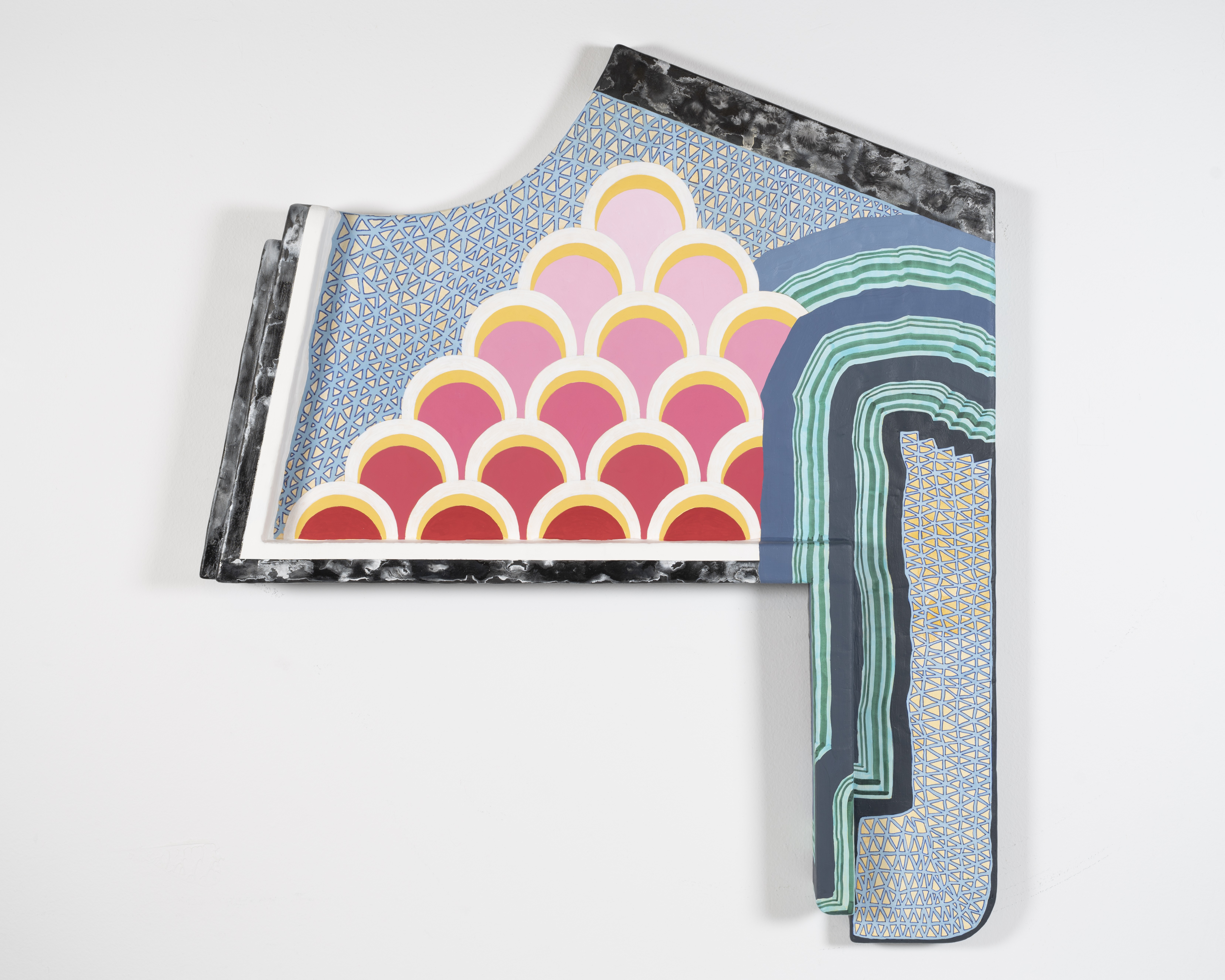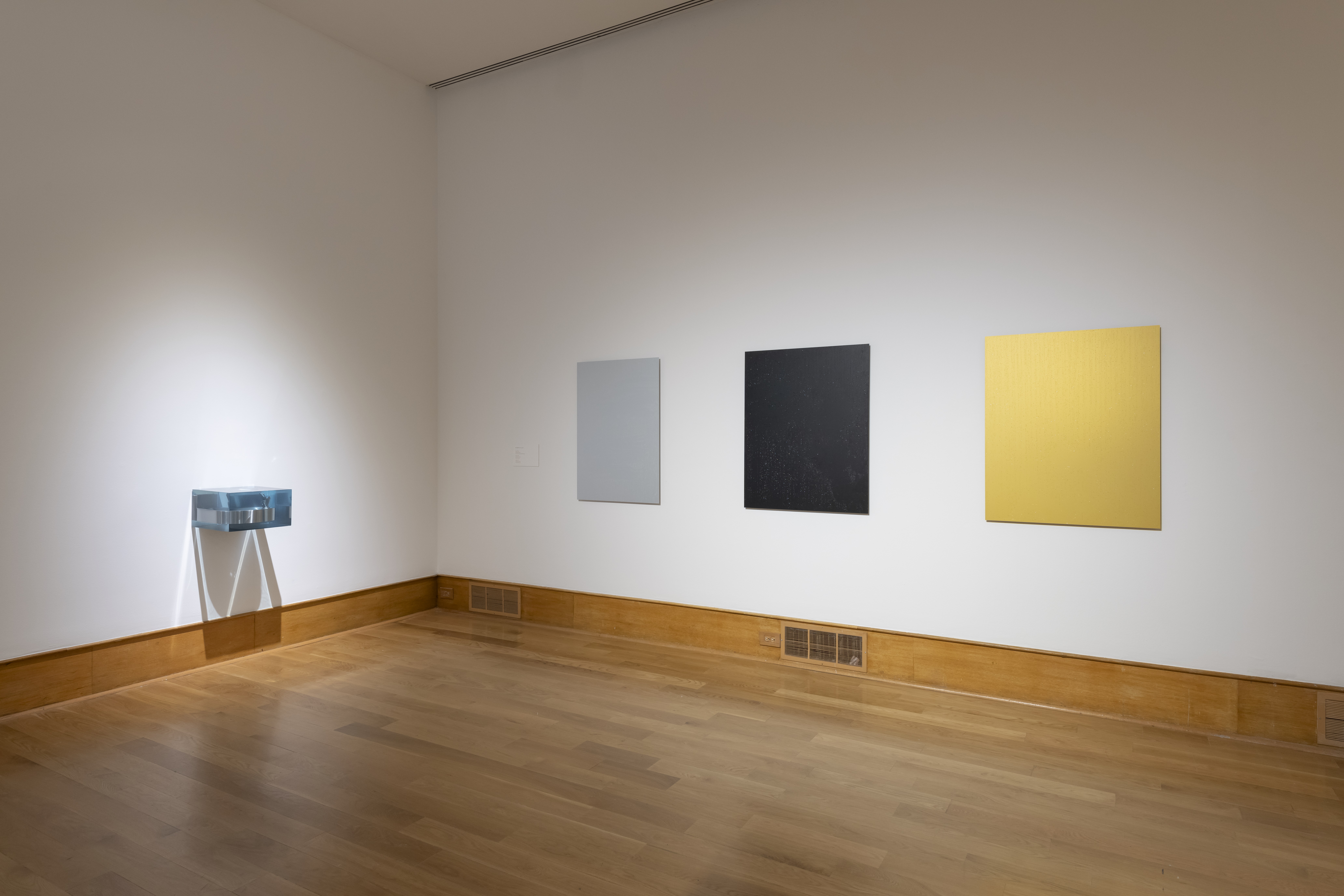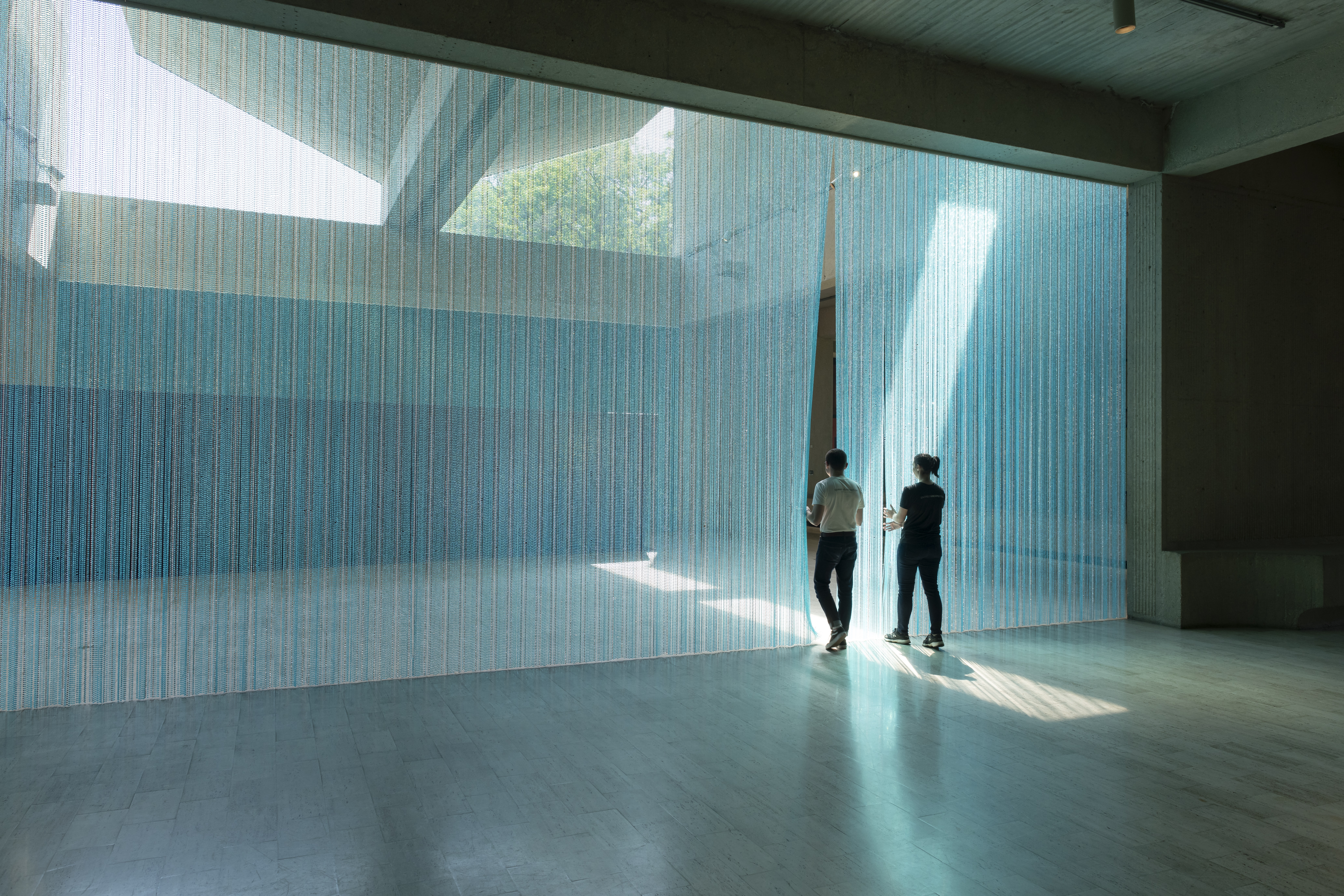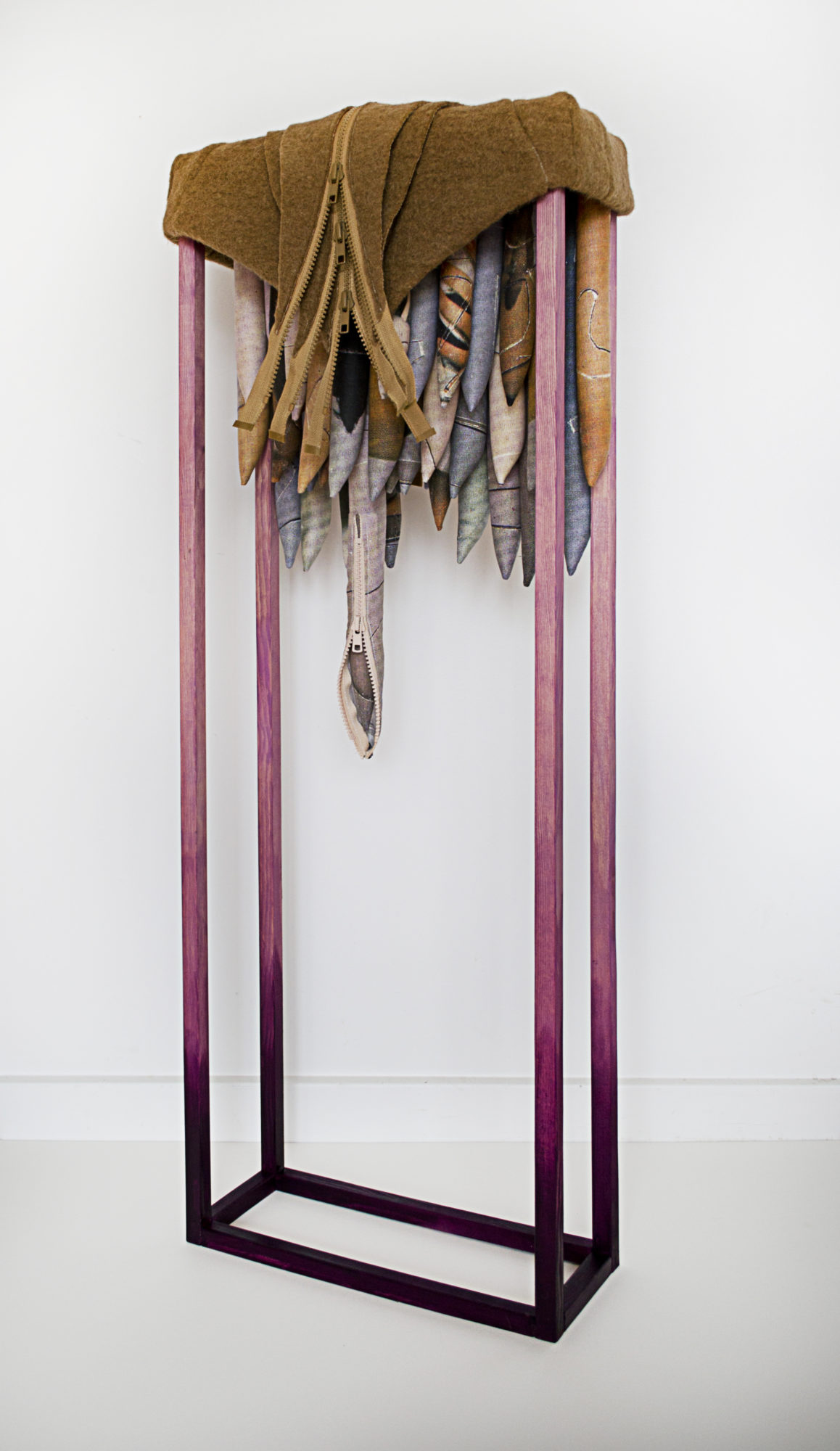Queer Abstraction at Des Moines Art Center

Image of Queer Abstraction installed at the Des Moines Art Center. Image courtesy of the Des Moines Art Center. Photograph by Rich Sanders.
Queer Abstraction, Des Moines Art Center, Des Moines, IA, June 1 – September 8, 2019.
Harmony Hammond has argued for the “transgressive potential of abstraction.”(Harmony Hammond, Lesbian Art in America (New York: Rizzoli, 2000), 89.) Hammond is included in the Queer Abstraction exhibitionat the Des Moines Art Center along with artists Math Bass, Mark Bradford, Elijah Burgher, Tom Burr, Mark Joshua Epstein, Edie Fake, Felix Gonzalez-Torres, Nicolas Hlobo, John Paul Morabito, Carrie Moyer, Sheila Pepe, Prem Sahib, Jonathan VanDyke, and Jade Yumang. The contemporary works in this exhibition demonstrate the “transgressive potential” of “queer abstraction”. Curating a show around this premise is tricky, as both the terms “queer” and “abstraction” have complicated histories and are loosely defined. In the opening essay of the Queer Abstraction catalog “Queer Abstraction, Queer Possibilities: An Introduction,” curator Jared Ledesma argues that abstraction as a strategy allows for the slipperiness of gender expression that many queer artists want to convey. He defines “queer” as “a reference to the lesbian, gay, bisexual, and transgender communities, unless noted otherwise.”(Jared Ledesma, “Queer Abstraction, Queer Possibilities: An Introduction,” in Queer Abstraction (Des Moines: Des Moines Art Center, 2019), 13.) For the purposes of this review, I will rely on this definition of the term “queer.”
While many queer theorists are divorcing queer theory from LGBT identity, Ledesma chose artists who identify as queer and understand their art practice as linked to their identities. This link between the term “queer” and the lives of the LGBT+ artists included in the show is significant. Many of the pieces in the show were created specifically for the exhibition. Temporary walls were removed from the large gallery space, allowing the pieces to be in visual communication with each other. While a variety of techniques and media are present, most of the work is brightly colored and highly detailed; this gives the exhibition a lively, joyous feeling overall.
Math Bass and Eligh Burgher subvert signs and symbols to create a new queer language. Bass’s piece Newz! draws from pop culture gender symbols to discuss gender’s slippery nature. Gender tensions can be seen in Bass’s work as the positive and negative spaces fight for primacy to present either a phallus or a vagina. Burgher draws from the coding system of occultist Austin Osman Spare to create complex ritual documents. His New Horny Sun Vision is displayed on the floor of the gallery space, inviting visitors to participate in the ritual making by walking or sitting on it. While the piece is busy with symbols, empty background spaces peek through, signaling that the piece is still active and can continue to be used.

Math Bass. Newz!, 2019. Gouache on Canvas. 41 x 44 in. Image courtesy of the artist.
The use of decorative pattern, high detail, and bright colors is notable in the show. Artists Mark Joshua Epstein and Edie Fake offer contrasting takes to this aesthetic. Fake has five pieces in the show which all are highly geometric and architectural in feel. Though Fake uses a bright palette of colors and a mix of opaque and gradient areas, the main structure of his work is composed of linear, highly planned elements that give the pieces a poppy design feel. Egg Palace and The Keep resemble facades of queer-only space. The viewer glimpses only the outsides and must guess what secrets the interiors hold. Unlike Fake’s structured approach, Epstein’s constructions have a quirky irregularity to them. The painting panels have been molded into asymmetrical shapes that are framed on some sides and open on others. Colorful, complex patterns cover the works, and sometimes seep onto the frames. The works by Epstein have been specially installed onto a dark-pink painted section of the gallery. The bottom of this wall section has been detailed with a zig-zag line that escapes out of the tight frame and onto the white gallery wall. The work and the installation give the feeling of decorative excess which cannot be contained.

Mark Joshua Epstein, Working Lunch, 2018. 25 x 23 x 2 ¼ inch. Image courtesy of the artist. Photograph by Guy Ben-Ari.
While representational queer figures are not presented in this show, the queer body is present in many of the works. Artists Harmony Hammond and Mark Bradford contribute large, visceral works that reference the body through thick irregular textures and a very physical making processes. Hammond’s two pieces Fuse and Chenille #2 hang on the wall and act as heavy, protective doors. Chenille #2 is a warm cream color. Thick paint layers over cloth and pieces that resemble bolts. A vertical cut runs through to left-middle of the painting. A rich red seeps out, suggesting a living body underneath a crust of residue. Many of the works in the exhibition, including Hammonds, draw from Feminist Abstraction. The use of fibers, the decorative, and feminine colors are notable throughout. As quoted previously, Hammond is a strong advocate for abstraction as a tactic for women artists, as it evokes affective responses viewers while not permitting the objectification of the female body.
Killing the Goodbye by Bradford hangs to the right of the two Hammond pieces. Killing the Goodbye is one of a handful of pieces in this exhibition that discusses the AIDs crisis. A queer African American man, Bradford’s work foregrounds the struggles of Black Americans. Killing the Goodbye points to people of color who have been historically overlooked in the AIDs crisis. The dynamic, wall-sized painting shows red and black lines which violently intersect over a background of pink, yellow, and white, suggesting HIV-infected T-cells. Indeed the force of the infection is felt through the dynamic and erratic lines and also in the physicality of the painting process.
While the crevices, textures, and imagery of Hammond and Bradford give visual cues to the queer body, the work of artists John Paul Morabito and Prem Sahib are more subtle as they reference the body through indexical traces of touch. The fiber weavings by Morabito layer the artist’s touch through manual and digital processes. The monochromatic, rectangular weavings have a base color of white. Black lines create patterns that cover their surfaces. To make these pieces, Morabito first hand-weaves pieces of fabric. The artist then manually creates a rubbing of the weaving onto paper with charcoal. The motion of their hand moving over the textures of the cloth are preserved on the paper. The rubbing is then scanned into a computer and a digital loom prints the final weaving. These pieces document layers of a maker’s touch, and like the work of Hammond and Bradford, they evoke the queer body. Three of the five pieces that Sahib has in the exhibition are also viscerally evocative. Taker X, Beyond I, and Andreas are vertical, aluminum panels, covered with irregular dots of resin. These works, which are tinted silver, black, and gold respectively, represent the walls of a nightclub, wet with condensation and sweat. Patrons run their hands over the walls, creating voids and patterns in the moisture. The queer space of the nightclub enters into the public sphere of the gallery as resin on metal permanently documents these transient, physical interactions, preserving touches.

Prem Sahib (from left to right) Roots, 2018. Steel Drinking Fountain, Resin. 9 1/16 x 15 3/16 x 14 3/8 in. Taker X, 2014. Aluminum, Resin. 39 3/8 x 27 9/16 in., Beyond I, 2015. Aluminum, Resin. 39 3/8 x 27 9/16 in., Andreas,2017. Aluminum, Resin. 39 3/8 x 27 9/16 in. Image courtesy of the Des Moines Art Center. Photograph by Rich Sanders.
Like Sahib, other artists included in the show also create queer sites in the gallery space, bringing private moments and memories into public spaces. Large-scale pieces by Felix Gonzalez-Torres and Tom Burr were meticulously recreated by the curatorial team at the Des Moines Art Center to be installed in the museum’s I.M. Pei wing. The bright and irregular pieces give the muted, brutalist space a new energy. “Untitled” (Water) by Gonzalez-Torres consists of long, hanging sequences of aqua-blue beads which fill the space with movement and blue-light reflections. The artist required the work to be hung in doorways where museum visitors were required to pass through. There are several walls of beads hanging in the gallery space and they create both access points and barriers for visitors. Parts of the gallery are sealed off to become quiet, private places for visitors to spy through to the larger space. Gonzalez-Torres created the piece to honor the fond memories that he had with his late partner Ross Laycock around this color of blue. Both Gonzalez-Torres and Laycock died from AIDs in the 1990s, and the energy of the piece acts to resurrect these lives and memories in the present.

Felix Gonzalez-Torres, “Untitled” (Water), 1995, Strands of beads and hanging device. Dimensions vary with installation. Image courtesy of Des Moines Art Center. Photograph by Rich Sanders.
“Untitled” (Water) shares the same gallery spaces as Deep Purple by Tom Burr. This piece is a queer take on Richard Serra’s infamous Tilted Arc. Acting like the Tilted Arc, Deep Purple transects the space, forcing visitors to move in a specific way. Unlike Tilted Arc, Deep Purple is created from wood and is painted a matte plum color that reflects light in way that gives the illusion of a soft velvet coating. The piece cuts through the space and out through the wall-sized window into a courtyard area outside. The combination of “Untitled” (Water) and Deep Purple in the same space activates and subverts the traditional gallery experience inviting visitors to participate in queer memory and community.
The pieces in this exhibition have a way of compressing time as the past, the present, and the future are all active in the pieces. Whether they transform art historical traditions like the work of Harmony Hammond and Tom Burr, bring memories back to life like the work of Felix Gonzalez-Torres and Prem Sahib, or hypothesize the radical potential in queer futurity like the work of Edie Fake, this exhibition invites visitors to participate in an active form of queer time. Jade Yumang’s fiber sculptures demonstrate this quality the most as they transform archival materials into dynamic, queer forms. Yumang took images from a My-O-My magazine which was confiscated by the police during a 1972 raid of a gay bookstore. The erotic photographs have been printed onto fabric, which has been sewed into phallic, pendulum-like fiber forms. Each fiber work includes several of these pointed forms and combines them with other materials like felts, leather, and zippers. Both soft and menacingly pointed, the sculptures re-eroticize the original images turning them into dynamic, titillating sculptures that embody past and present dangers and desires.

Jade Yumang, Page 5, 2016. 36 x 14 x 6 in. Image courtesy of the artist.
Queer Abstraction is an exhibition that successfully demonstrates the exciting “transgressive potential” of categories that might appear vague. This show includes a diverse, international range of artists from the LGBT+ community whose work explores themes such as queer history, queer sites, the queer body, and the boundaries of queer aesthetics. Curator Jared Ledesma and the staff at the Des Moines Art Center have provided visitors with interpretive support to navigate this innovative show including signage, a catalog, and educational community events. Legibility is crucial to the queer community. An understanding of Queer subject matter and of abstraction is necessary to the success of a show like Queer Abstraction. While art savvy visitors can be acquainted with queer themes through the signage and catalog, queer visitors may also need to be introduced to abstract art objects and their position in art history. These challenges should not be deterrents to innovative shows like Queer Abstraction; rather, museums should prioritize audience understanding and education.(This review has benefitted from a discussion with curator Jared Ledesma on July 15, 2019.)
Following the exhibition at the Des Moines Art Center, Queer Abstraction will be traveling to the Nerman Museum of Contemporary Art in Overland Park, KS where it will be on show from November 21st, 2019 – March 8th, 2020.





